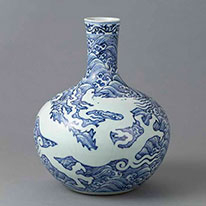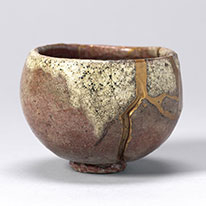General Information
To prevent the spread of the coronavirus, "Timed Entry Tickets" for this exhibition should be reserved online in advance.
A limited number of same-day tickets will be available for purchase at the museum's South Gate entrance (entry will be allowed during the time slot closest to the time of purchase). The number tickets available each day are limited and will become unavailable if sold out. We appreciate your understanding and cooperation.
Exhibition dates are subject to change and visitors numbers may be limited. Updates will be posted on this website and on the museum's official Twitter feed, so please check for the latest information before visiting the museum in person.
| Exhibition Title | Special Exhibition Masterpieces from the Hatakeyama Memorial Museum of Fine Art: Noh, Chanoyu, and Rinpa |
|---|---|
| Period | October 9–December 5, 2021 The exhibition has two installations: Part I: October 9–November 7, 2021 Part II: November 9–December 5, 2021 Some artworks may be rotated during the exhibition period. |
| Venue | Kyoto National Museum, Heisei Chishinkan Wing |
| Transportation | JR, Kintetsu Railway, Keihan Railway, Hankyu Railway, City Bus |
| Closed | Mondays |
| Special Exhibition Hours | 9:00 a.m.–5:30 p.m. (Entrance until 5:00 p.m.) |
| Special Exhibition Ticket | Admission Adult 1,800 yen Univ. Student 1,200 yen High School Student 700 yen
To prevent the spread of the coronavirus, tickets for this exhibition should be reserved online in advance. To alleviate congestion in the galleries, entry priority will be given to holders of "Timed Entry Tickets," so we recommend visitors to please purchase a "Timed Entry Ticket" prior to visiting the museum. Admission times are divided into hour-long time frames, and visitors must enter the museum within the time slot printed on their tickets. In addition, a limited number of same-day tickets will be available for purchase without a reservation at the museum entrance. Purchasers of same-day tickets will be allowed entry during the time slot closest to the time of purchase. Tickets for each day are limited and will become unavailable if sold out. We appreciate your understanding and cooperation. "Timed Entry Tickets" and "Campus Members Timed Entry Tickets" can be reserved through the Lawson Ticket website up to a day before your visit. After making your reservation online, tickets can be printed and purchased at any Lawson or MiniStop convenience store. Tickets go on sale at 10:00 a.m. on Thursday, September 9th. --ENDED-- |
| Audio Guide | under construction |
| Catalogue | Available at the Museum Shop Special Exhibition Catalogues |
| Organized by | Kyoto National Museum; Hatakeyama Memorial Museum, The Ebara Hatakeyama Memorial Foundation; Nikkei Inc.; NHK (Japan Broadcasting Station) Kyoto; NHK Enterprises, Inc. Osaka Branch Office |
| With the support of | Taisei Corporation |
Description of This Exhibition
The Hatakeyama Memorial Museum of Fine Art houses the collections of Ebara Corporation founder Hatakeyama Issei (1881–1971), better known in the tea world as Sokuō. This special exhibition introduces masterworks of Japanese, Chinese, and Korean art from his museum, which has long been closed for renovation, with a focus on prized objects used in Chanoyu tea gatherings, as well as masks and costumes for the Noh theater and artworks expressing the decorative aesthetic of Rinpa. Hatakeyama marked the storage boxes of his favorite tea utensils with a red seal reading "Sokuō; Cherished Pleasures, Offered to the People" (Sokuō yoshū aigan). This phrase exemplifies his interest in not monopolizing such objects for himself but instead in sharing them with the public. Enjoy this unique opportunity to immerse yourself in the aesthetic world created by Hatakeyama Sokuō through the early artworks that he loved.
Part 1. Origins of the Collection and Kanazawa
Hatakeyama Issei (1881–1971), better known in cultural circles by his artistic sobriquet Sokuō, was born in Kanazawa, a prosperous castle town long administered by the Maeda clan of the Kaga domain. After graduating from university, Hatakeyama worked as an engineer. He became active as a tea practitioner while running a company that designed and manufactured pumps. In 1915, he made his first purchases of Kutani type ceramics produced in the region around Kanazawa.
Kutani ware was generally popular among collectors during the Taishō period (1912–1926), but it held special meaning to Hatakeyama because of its connections to his hometown. This initial section of the exhibition introduces Hatakeyama's early acquisitions and other works related to Kanazawa.
-
-
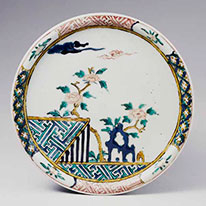
-
Plate with Peonies
Hatakeyama Memorial Museum of Fine Art
-
Part 2. The Noh Theater: Foundational Aesthetics
The transformation of Japanese society during the Meiji period (1868–1912) also led to changes in the primary patrons of the Noh theater. The families of former provincial daimyo lords, who no longer needed to hold grand Noh theater performances, began deaccessioning their family collections; in their place, wealthy Noh aficionados from the business world stepped in as supporters of this theatrical tradition.
Hatakeyama Issei (Sokuō) was one such industrialist. Himself a student of Noh chanting and dance, he actively collected Noh costumes originally owned by the Maeda clan of Kaga, even donning them for his own performances.
Noh plays revolve around essential aspects of Japanese culture, including narratives, myths, and temple and shrine origin stories; they incorporate the country's religions, literature, and even topography. The aesthetics of Noh, which expresses internal psychological landscapes through chanting and dance, formed a foundation for Hatakeyama's artistic sensibilities.
Part 3. Encountering Masterworks through Chanoyu
Chanoyu is the Japanese practice of gathering to drink powdered green tea (matcha) and appreciate objects used in the tearoom. Known in tea circles as Sokuō, Hatakeyama Issei was an active practitioner of chanoyu and an avid collector of famous tea utensils. He acquired renowned Ido tea bowls and imported (karamono) tea containers once owned by famous warlords, as well as masterworks of painting and calligraphy. The more idiosyncratic works in his collection, including masterworks by Heian period calligraphers and exceptional tea bowls, reveal Hatakeyama's discerning eye and distinctive tastes.
Hatakeyama was much younger than the famed industrialist and tea practitioner Masuda Takashi (Don'ō, 1848–1938), but he was sometimes asked to prepare tea at Masuda's tea gatherings and considered him a mentor. Hatakeyama later amassed objects formerly owned by Masuda and other major tea practitioners and art collectors of the modern era, including Hara Sankei (1868–1939).
Part 4. Rinpa
The Hatakeyama Memorial Museum of Fine Art has a large and notable collection of works in the stylized artistic mode known as Rinpa, including a stellar handscroll of the Kokin wakashū (Collection of Ancient and Modern Japanese Poems) by Hon'ami Kōetsu (1558–1637) and Tawaraya Sōtatsu (dates unknown). The collection stands out not only for its quality but also for the systematic approach with which it was acquired.
The lineage of Rinpa artists accepted today—beginning with Kōetsu and Sōtatsu, continuing with Ogata Kōrin (1658–1716) and his brother Kenzan (1663–1743), followed by Sakai Hōitsu (1761–1823) and Suzuki Kiitsu (1796–1828)—was actually conceived in the early twentieth century and has evolved over the years. The systematic collection of Rinpa works by Hatakeyama Sokuō overlapped perfectly with the conceptual development of "Rinpa" in the modern era.
Part 5. A Spirit of Generosity, "Cherished Pleasures, Offered to the People"
The phrase "cherished pleasures, offered to the people" (yoshū aigan) expresses the concept that art collections should not be monopolized by the few but shared and enjoyed by a wider group of connoisseurs. Hatakeyama was so taken with this adage that he used it on his collector's seal. His decision to establish the Hatakeyama Memorial Museum of Fine Art was a way to put its ideals into practice.
After resolving to establish a museum, Hatakeyama began acquiring world-class works of art to supplement his tea utensils collection, such as the Chinese porcelain Globular Bottle with Dragon and Waves. Hatakeyama wanted his collection to be appreciated by a wide range of people, especially young people, so he began seeking not only tea wares but also works that he considered suitable for viewing within a museum context.
Part 6. Hatakeyama Sokuō and Tea
Hatakeyama Sokuō enjoyed and practiced chanoyu for about forty years beginning in the mid-1920s. He was especially particular about the kaiseki cuisine served at tea gatherings, actively involving himself in everything from the menu selection and flavoring of the food to the choice of dishes upon which to serve it.
Hatakeyama showcased his collections at two of the most important annual tea gatherings in Japan, the Kōetsu Kai in autumn in Kyoto and the Daishi Kai, held in spring in Tokyo. For example, his Bizen ware Fresh Water Jar with Fire Markings was featured in the Kōetsu Kai in 1934, and his calligraphy scroll Words of Departure by Nanchu Shishuo and Ido Tea Bowl, Named "Nobunaga" were both used at the Daishi Kai in 1937. These and other objects in his collection allowed Hatakeyama to create lavish ensembles of renowned tea utensils. This part of the exhibition reunites some of the iconic utensils used together in tea gatherings of the past.











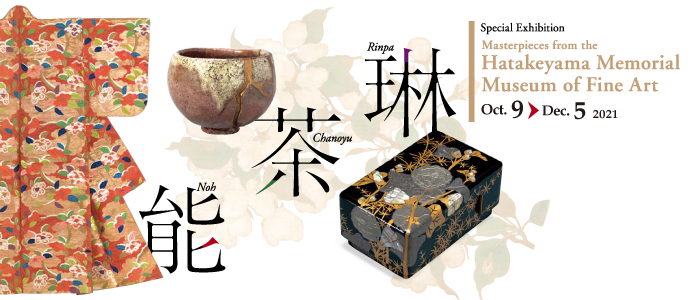
![Important Art Object. Flowering Trees of the Four Seasons (Left Screen). By Watanabe Shikō. Hatakeyama Memorial Museum of Fine Art [on view: October 9–November 7, 2021]](../../../jp/special/img/20211009/hatakeyama2021_4-1_2F-4_tmb.jpg)
![Noh Costume, Karaori (Narrow-Sleeved Robe) with Snow-Laden Camellias over Clouds. Hatakeyama Memorial Museum of Fine Art [on view: November 9–December 5, 2021]](../../../jp/special/img/20211009/hatakeyama_20211009-1_tmb.png)
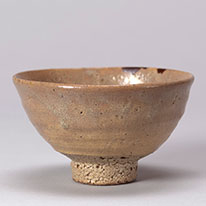
![Noh Mask, Okina (Hakushiki Jō). Attributed to Fukurai. Hatakeyama Memorial Museum of Fine Art [on view: October 9–November 7, 2021]](../../../jp/special/img/20211009/hatakeyama2021_2-1_3F-2_tmb.jpg)
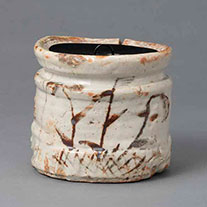
![National Treasure. Evening Bell from a Mist-Shrouded Temple. Attributed to Muqi. Hatakeyama Memorial Museum of Fine Art [on view: November 9–December 5, 2021]](../../../jp/special/img/20211009/hatakeyama2021_3-2_2F-2.jpg)
![Important Cultural Property. Kokin wakashū (Collection of Ancient and Modern Japanese Poems) over Underpaintings of Plants and Flowers of the Four Seasons. Calligraphy by Hon'ami Kōetsu , painting by Tawaraya Sōtatsu. Hatakeyama Memorial Museum of Fine Art [on view: November 9–December 5, 2021]](../../../jp/special/img/20211009/hatakeyama_20211009-3_tmb.jpg)
![Important Cultural Property. Azaleas. By Ogata Kōrin. Hatakeyama Memorial Museum of Fine Art [on view: October 9–November 7, 2021]](../../../jp/special/img/20211009/hatakeyama2021_4-1_2F-3_tmb.jpg)
